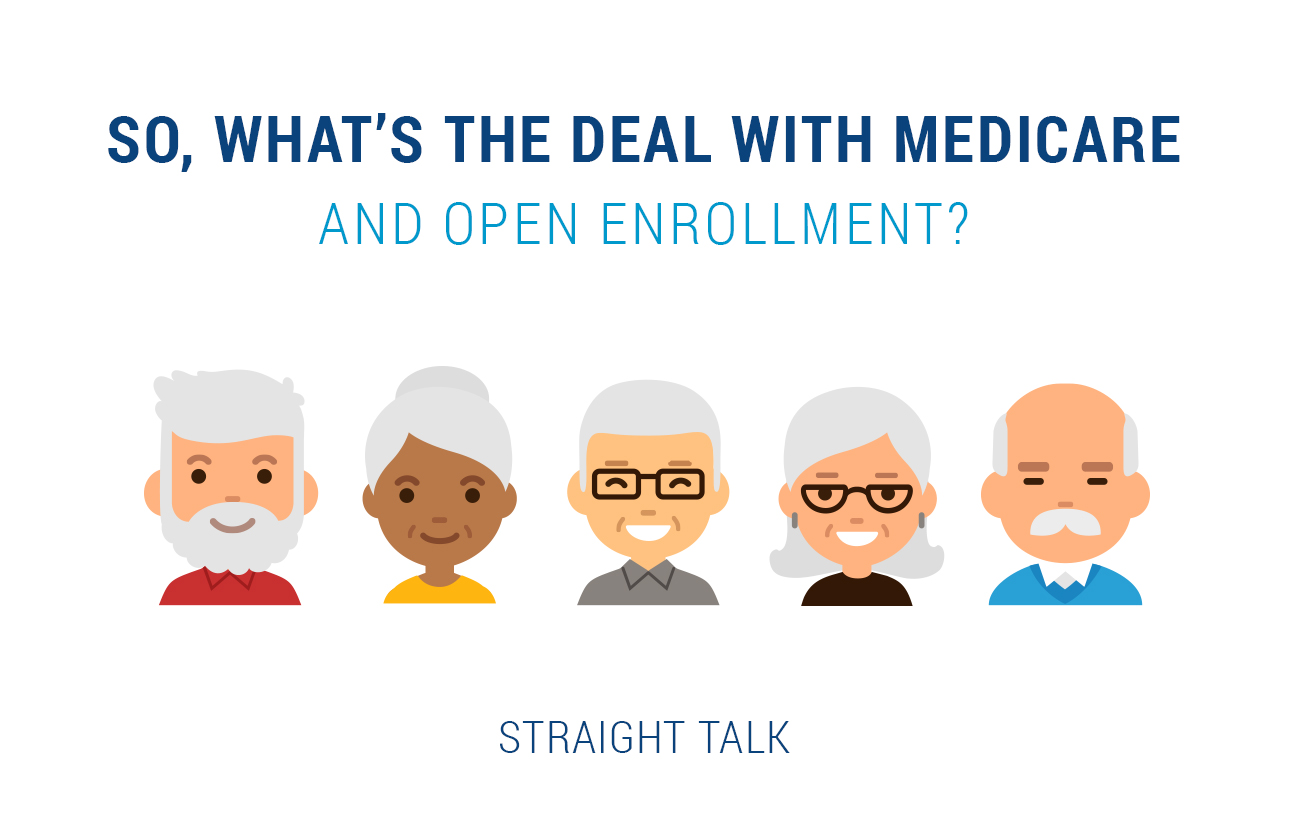Every year, tens of thousands of my friends and neighbors here in Louisiana turn 65 years old, thus “aging in” to the Medicare program. They will be joining over 55 million Americans already in the program.
If you have Medicare, you probably know that every fall brings a chance to make changes to your coverage during open enrollment (also called the Annual Election Period). This means that every year from Oct. 15 – Dec. 7, you can review your coverage and see if you need to make any changes for next year. If you decide you are happy with the plan you have now, you don’t need to do anything. But if you want to make a change, now is the time to do it.
You would think when you sign up for Medicare, you could just breathe a big sigh of relief and then say, “Sweet! I paid in all these years, now the government will take care of all my healthcare costs! I earned it, after all!”
If only.
Don’t get me wrong; Medicare is a huge and wonderful benefit, and I know plenty of people who are glad they have it.
As open enrollment for Medicare is happening right now, I thought this was an opportune moment to talk about the good stuff, and the not-so-good stuff, about Medicare.
First, the Different Parts
Medicare has basically three parts you need to worry about:
Part A covers care you get when you are in the hospital, in a skilled nursing facility, in hospice or, in very limited circumstances, when you are at home.
Part B covers most medically necessary doctors’ services, preventive care, durable medical equipment, hospital outpatient services, laboratory tests, x-rays, mental healthcare and some home health and ambulance services.
Part D provides coverage for prescription drugs.
So Mike, that sounds pretty comprehensive to me! What’s the problem?
The problem is each of these parts has different rules about what you have to pay in premiums and out of your pocket to access that care. None of them are free. And all three have limits and caps on treatments, but not limits or caps on what you pay out of pocket (except Part D). So, let’s talk about the money.
What You Pay Every Month in Premiums
Part A – If you worked during your life and had Medicare taxes withheld from your paychecks for at least 40 quarters of work (10 years), then you don’t pay any premiums for Medicare Part A. For 2017, if you worked 30-39 quarters in your life, the premium is $227/month. If you worked fewer than 30 quarters? $413/month. Most people on Medicare Part A pay $0.
Part B – Premiums for Part B are set based on your prior-year income. For 2017, those premiums range from $134 – $428.60 a month.
Part D – These plans are privately run and subsidized for seniors to help keep costs down for their drug coverage. Up to a certain income, the average premium for 2017 was just a little over $60/month, but these premiums, too, are adjusted based on income. For 2017, the least someone might pay is just the plan premium. The most would be the plan premium + $76.20.
That said, it’s not too hard to imagine the average Medicare beneficiary paying $0 for Part A premiums, $134 for Part B and around $60 for Part D each month. Figure a little under $200 a month in premiums to have the total Medicare “package.”
What it Actually Costs You to Use Medicare
For 2017, you could expect to pay:
Part A – Hospital Stay
- $1,316 deductible; plus
- $329/day copay for each hospital day after 60 days; plus
- $658/day copay for each hospital day after 90 days; plus
- 100% of costs for each hospital day when you use your 90 days, plus your 60 “lifetime” hospital days
- $164.50/day copay for each skilled nursing facility day after 20 days; plus
- 100% of costs after the 100th day of skilled nursing per year.
Part B – Doctors and Services
- $183 deductible
- 20% coinsurance with no cap, or limits, after the deductible. No limit.
Part D – Prescription Drugs
- $400 deductible (sometimes less depending on plan design)
- 25% of all costs after the deductible, to the initial limit of $3,700
- 100% of all costs between $3,700 and $7,425
- Very small copays over $7,425 up to a max out-of-pocket of $4,950 per person.
It’s worth noting that ONLY Part D offers the consumer maximum out-of-pocket protection. There are no limits to a retiree’s liability under Parts A and B.
So again, an illness that required hospitalization would lead to the insured person paying the $1,316 Medicare deductible, the $183 Part B deductible and 20% of all non-hospital medical costs after that. Could be a lot of money, this Medicare thing.
How Do People on Medicare Typically Manage the Financial Risk?
There are two ways commonly used to mitigate some of these scary financial consequences:
- Medicare Supplemental Plans (Med Supps) are plans that, for an additional fixed premium each month, fill in all the gaps that Medicare doesn’t pay. They typically cover the deductibles, daily copays and all other things that Parts A and B leave exposed. Note that federal action is changing these plans, and people who buy them in 2020 and beyond will have to pay the normal Part A/B deductibles out of pocket before the Med Supp plan will be allowed to kick in and pay everything else. At least 12 million of the 55 million Medicare folks have a supplement plan.
- Medicare Advantage Plans (MA plans, also known as Part C) completely replace Medicare parts A/B and often Part D with a single insurance product offered by a private insurance company (like Blue Cross and Blue Shield of Louisiana). MA plans can have premiums as low as $0, and often offer $0 deductibles as well. The plans are required by federal law to also offer maximum out-of-pocket spending limits, unlike Medicare Parts A and B. And MA plans cannot limit care payments to a specific number of hospital days like Part A. MA plans have all the consumer protections that employer coverage has, but are designed specifically for Medicare recipients. Almost 18 million of the 55 million Medicare folks have an MA plan.
When Can People Buy Medicare Plans?
Whenever people turn 65 years old, they have a certain length of time to sign up for Medicare and, if they choose, to enroll in a Medicare plan from a private insurer. You also have your open enrollment period I talked about earlier to make any changes. Take advantage of that opportunity to be sure you have the best coverage for your needs. It’s important to note that Medicare Supplement plans do not have an annual enrollment period. You become eligible on the first day of the month you turn 65 or with your Part B effective date. Your enrollment period lasts for six months.
Hope this helps!…Don’t miss open enrollment!





Great job,as always,Mike,and I am a Broker as is my wife and we are having perhaps our most successful AEP’s ever,thanks in large part to Blue Advantage offering a nice array of attractive benefits and we just happen to be working in the Tangipahoa area,where folks have been clamoring quite loudly about having to “pay a premium” for a plan their buddies in other Parishes get “free”!!!
All kudos to our product development team, our provider network team, and our Actuarial/Underwriting team, all of whom are working in a tiny little federally-specified box, trying so hard to design products that can actually be afforded even under the ACA, it’s a very tough, tough challenge! I’m glad we hit a few sweet spots for you. And please keep the comments coming!
Best of luck during open enrollment!…mrb
I am still confused. I am in active service and god fathered or what ever in Group benefits plan. I eligible to enroll in medicare. I am a resident of Louisiana. I would appreciate if one advises me as early as possible to make use of the current enrollment options
Bobba!
I need a little more information to help you, but here are some things you can consider. IF you are in an employer plan, your employer’s HR folks should always be your first stop in trying to gather information, due to the enormous variety of plans out there in the working world. If they are offering you a plan that coordinates with, or overlaps Medicare you need to know that before you make any decisions.
If that’s not the case, recommend you contact a broker/agent who can guide you through this morass of picking the plan that is best for you. Ours are at http://www.bcbsla.com.
thanks!…mrb